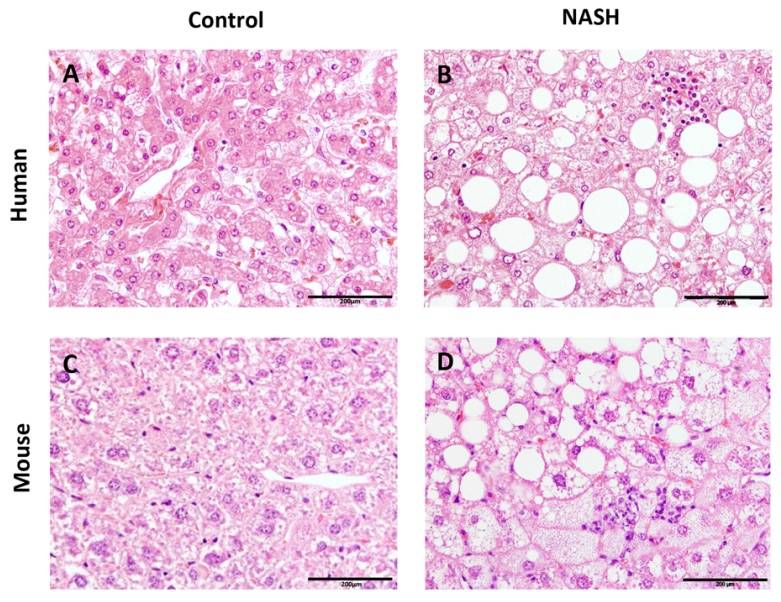Non-Alcoholic Steatohepatitis (NASH) Modeling & Pharmacodynamics Services
Creative Biolabs is offering the custom nutritional models of NAFLD/NASH to meet our clients' specific requirements. In terms of extensive experience, our scientists are willing to set up a detailed research plan based on your specific needs and provide services to evaluate the efficiency of potential treatments.
Nonalcoholic fatty liver disease (NAFLD) and nonalcoholic steatohepatitis (NASH)
Nonalcoholic fatty liver disease (NAFLD), one of the most common chronic liver disease, is a condition characterized by abnormal excessive fat accumulation in the liver of a patient without a history of alcohol abuse. NAFLD/NASH is regarded as a hepatic manifestation of metabolic syndrome, with an increasing incidence worldwide in parallel with obesity, hyperlipemia, and type 2 diabetes. NAFLD includes a wide spectrum of liver abnormalities that may vary from simple steatosis (nonalcoholic fatty liver) to NASH. As a potentially progressive form of NAFLD, the mechanisms involving the pathogenesis of NASH are not completely clarified. Due to ethical limitations and long formation time of using human materials, animal models of NAFLD/NASH that not only can elucidate the pathogenesis but also examine therapeutic effects of various agents are widely used by investigators.
 Fig. 1 Histological photomicrographs of human and mouse NASH.1
Fig. 1 Histological photomicrographs of human and mouse NASH.1
Methionine-Choline Deficient (MCD) Diet
One of the most widely used NASH models is induced by feeding animals with methionine-choline deficient (MCD) diet, containing high sucrose and fat (40% sucrose, 10% fat) but lacks methionine and choline, which are essential for hepatic β-oxidation and production of very low-density lipoprotein (VLDL). The main results of feeding the MCD diet are hepatocyte lipid accumulation and decreased synthesis of VLDL. The severity of NASH that develops in rodents fed the MCD diet depends on the animal gender and strain. Typically, they are characterized by weight loss, steatosis, and necroinflammation. The main advantages of the MCD diet are that it is easy to obtain and use.
High-Fat Diet (Western Diet)
Animal models fed with western diet, high-fat diets leading to obesity, insulin resistance and liver damage can be used to investigate NASH due to the strong links between NAFLD and metabolic syndrome. The main advantages of these models are that they represent the detrimental eating habits of the Western diet and thus imitate the etiology of NAFLD/NASH. But the degree of liver injury is mild compared with the MCD model.
High-Cholesterol and High-Cholate Diet
Atherogenic diets, containing cholate and cholesterol, can induce atherosclerosis and the resulting NASH in animals. What's more, in mice fed with a combination diet of high fat and atherogenic diet, progressive formation of steatosis, inflammation, fibrosis as well as hepatocellular ballooning can be observed, which can replicate the pathophysiological findings of human NASH.
Creative Biolabs provides assessments for testing the effectiveness of potential drugs depending on your study objectives, which including but not limited to:
- Clinical Observations
- Body Weight
- Liver Weight
- Pathological Evaluation
- Biochemistry Analysis
- Insulin Tolerance Test
Additionally, Creative Biolabs also offers other types of rodent metabolic disease models that you may be interested in:
- Streptozotocin (STZ)-Induced Diabetic Model
- Streptozotocin-Nicotinamide-Induced Diabetic Model
- Alloxan-Induced Diabetic Model
- High-Fat Diet/STZ Induced Diabetic Model
- Cafeteria Diet-Induced Obesity
- High Fat Diet-Induced Obesity Model
- Intrauterine Growth Retardation (IUGR)-Diabetic Model
- Monosodium Glutamate (MSG)-Induced Obesity Model
- Partial Pancreatectomy Diabetic Model
If you are interested in our nutritional models of NAFLD/NASH, please do not hesitate to contact us or send us an inquiry. Our scientists are pleased to tailor the best-fit proposal to meet your demands.
Reference
- Liang, Wen et al. "Establishment of a general NAFLD scoring system for rodent models and comparison to human liver pathology." PloS one vol. 9,12 e115922. 23 Dec. 2014, doi: 10.1371/journal.pone.0115922. Distributed under Open Access license CC BY 4.0, without modification.
For Research Use Only.
